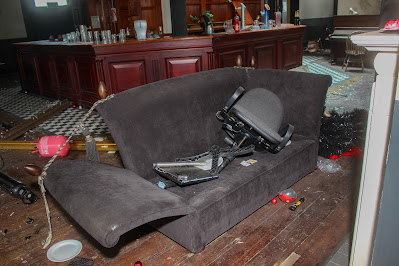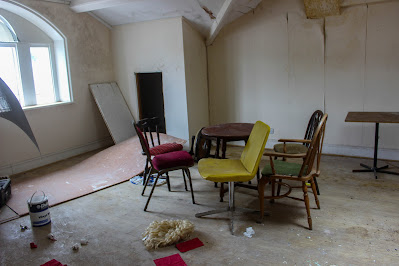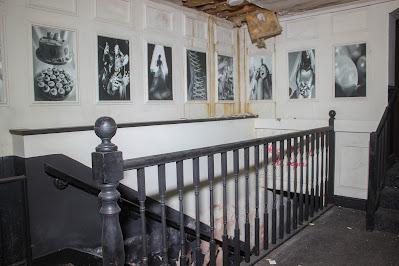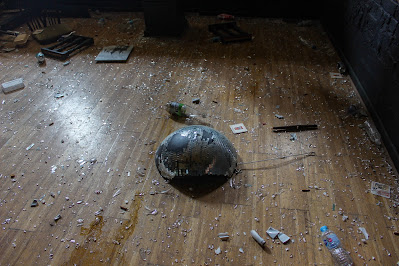When it comes to urbex, pubs tend to interest me the least. Sure, there's a wealth of history and fond memories for thousands of people dating back centuries, but aesthetically they get a bit samey. There's only so many times one can look at a bar. Unless they're serving alcohol, they aren't particularly exciting, and here in the UK they can still disappoint when they say "Is pepsi okay?" when you order a rum and coke. (Looking at you, Wetherspoons). But if I have a personal connection to a pub, like I used to drink there, then obviously it matters more and I'll take some time out of my busy life of being a bad influence to give it a quick mooch. And obviously, if it's got a story behind it then that lures me in like Kate McCann to a Tapas restaurant. If the building itself is bloody gorgeous, then that's sure to appeal to me too, and that brings us to the Crying Tree.
Check it out! This place is absolutely stunning! Right in the main entrance we have these two statues, some lovely floor tiles, some stained glass, and a giant sparkly ceiling buttplug. It's all very grand.
And it all leads to this big central bar area with a piano, a grand staircase and a ginormous stained glass ceiling window.
I'm often reluctant to follow the herd in regards to urbex, preferring an authentic adventure instead of just following the masses to the flavour of the month. Nevertheless it's easy to see why this place became popular. As far as buildings go, this one is very pretty, and it's not the sort of thing that pops up on the radar regularly.
But we've been playing this game long enough to know that as soon as the herd gets hold of a location and smears it all over the internet and freely gives out the details of it to their friends, their friends friends, and their friends friends friends sisters friends, then its days are numbered. As soon as I saw images of this gorgeous ceiling window appearing on the internet five hundred times a week, I said "I give it a month." And now on my own visit you can already see some panels have already been smashed. My own images are over a year old, so I doubt any of this window is even still there. RIP, you beautiful bastard.
And then of course, we have the bar.
There's an old fireplace bellows sitting on the bar. That's pretty awesome. It's not every day I come across one of these.
Presumably someone would have been sat here, playing melodic music as the customers came in through the door. It would have created quite a pleasant vibe.
But beyond that grand entrance it all gets a bit shit. If you're thinking this place looks like it's been hit by a tidal
wave of inbreds and crackheads, that's because it actually has been hit
by a tidal wave of inbreds and crackheads. It was so obscenely popular
as an abandoned place, I'm amazed there's anything still here at all.
The vandalism is disappointing but not surprising.
But there is history here, and it all began with the Cunningham family, who spearheaded their way into the 19th
Century with James Cunningham and Betsy Stock, born in 1805 and 1800.
The two fell in love and got married in 1822, and then did as many
married couples do and decided to keep cum as pets. Soon there were
loads of little Cunninghams running around.
First
came Mary Jane in 1826, Harriet in 1828, Isabella in 1831, and then John William in 1834.
Most significantly, Harold was born in 1837 and Walter was born in 1839. A final daughter, Ada, came along in 1841. And then shortly after the birth of Ada, Daddy James died. I don't know how or exactly when, but he doesn't pop up again.
I was quite sad to see this painting destroyed by vandals. Seriously, who does this?
According to the 1851 census, the widowed Betsy was the head of her household, living with her adult daughter, but John and Walter had gone. And now living
with the family is 32-year-old Mary Pierpoint. Which brings us to an
interesting practice within this family- cousin swapping. See, Walter was at the home of John and Sarah Hacking, whose maiden name was Cunningham. Meanwhile John William was at the home of Samuel and Anne Stock, Betsy Cunninghams maiden name. Also living with the Stocks were Samuel's siblings, Isaac and Helen, and another Pierpoint, this one called Edward. It turns out that the Pierpoints are actually the children of Samuel Stocks sister, Cicely. They're all listed as cousins on the census, but I can't actually find the connection. I think the link
may actually be a couple of generations further up, which adds another layer of fascination. I understand
sending kids to live with their cousins, but if we're talking second or
third cousins then that's a little more unusual. Clearly this
family liked to keep track of their lineage, and they all kept to the same geographical area.
Samuel Stocks
father, Thomas, must have been one hell of a beast too. He had thirteen
children. Were his pants ever on? Even
in the only image of him, he's making a bit of an awkward self conscious just-been-caught sex
face.
But their kids being cousins would mean this chap and Betsy are siblings, and the dates don't really add up there. Thomas was born in 1763, while
Betsy wasn't born until 1800. Samuel, Helen and Isaac were all in their forties when John was seventeen.
So
as with Sarah, I haven't been able to find out quite how
they're related. I knew there has to be a link somewhere because too many names on their numerous
progeny were matching the census names that pop up among the Cousins of
the Cunninghams. But Thomas did have a brother called James,
and James was the name of Betsy's dad, so maybe there's the link. I'm not going to dig too deep because family trees are complicated and headache inducing.
Time to check out the best part of any abandoned building, the toilets.
Still in better condition than the toilets in some active pubs and clubs.
And now to slip upstairs!
So
John Cunningham was staying with his maternal cousins, Walter Cunningham was staying with his
paternal cousins, and staying with both of them were two Pierpoints. And none of these people
are first cousins, which just adds to the weird child-sharing
dynamic of the Cunningham/Stock brood. It seems that their children are frequently sent to
live
with their cousins for periods of time, and it's a little unusual but
kinda wholesome. Naturally it continued into adulthood. In the 1860s Sarah Hacking came to live with Betsy, while Betsy's son Walter was still living with Sarah's husband and daughter. I can't help but feel that there's more to this that I'm missing.
But all that is just family backstory and actually predates this house. This house is said to have been built in the 1870s, but there is documentation that proves John Cunningham was living here as early as 1868. Even though the city has now expanded into it,
back in the 1800s this area was just fields between two villages, making it very quiet and remote. It's often said to have been built to be the country home for the Cunningham son, Harold, but it's the poor widowed Betsy who is listed as the Head of the Household in the 1871 census. Harold was actually
nowhere to be seen at this point. He fucked off to Derby and got married. He only came to live here in 1873, after his wife Eliza died, bringing with him their two children, Reginald and Harold Jr.
So
it seems that as far back as 1868 Betsy fancied a rural retreat. It's not surprising really. She
was getting on a bit, and she was not only widowed, but had lost a daughter. Mary
Jane had died young, in 1863.
As for the other daughters, Isabella and Ada, they don't show up again either. At least not in any capacity that I can follow. It turns out that there are multitudes of Isabella and Ada Cunninghams all sharing the same year of birth. All of them marry different men and have very different futures, so I have no idea who are the ones I'm meant to be following. These two women are gone like a fart in the wind.
The
bottom line is, Betsy was done with it all now, and she just wanted a
place to be alone. This house was built to be her country retreat and according to the 1871 census, she only had Walter, Harriet and a bunch
of servants living with her. She
died in this house in 1872, a year before Harold and his kids came to live here.
A closer look at the ceiling window.
There's another bar upstairs, and here it's possible to glimpse another aspect of the buildings past. See, prior to it being named The Crying Tree, it was known as Grange Manor, and that name is still written on the mirror behind the bar. I guess they didn't replace it when they rebranded. Fortunately there are plenty of old photographs that show the building in its Grange Manor days.
It does look a lot more pub-like back then. It's amazing what a change in lettering can do for an overall vibe.
So
the Cunninghams were cotton brokers. Harold began as an apprenticeship
of Samuel Buchanan & Browne Oughterson, who were founding members of
the Cotton Brokers Association in 1841, a sort of Cotton Brokers
Illuminati. Ninety firms joined and they all met on Fridays to share intel so that they
could all make better informed business decisions and settle disputes
between buyers and sellers quickly and simply without the need of
expensive and time consuming legal bullshit.
As of the 1881 census, the occupants of this house are Harold, Walter,
Harriet and John all in their forties. Harold's sons are nine and eight,
and keeping the trend going is Constance Hacking, their cousin. It's a
very odd dynamic where a bunch of siblings have lived under one roof
long into their adult lives, and only one of them has married and had
kids, only to be swiftly widowed and forced back to the nest, almost as
if the universe is telling him off for leaving.
But
it's not as if this was all negative. They had this massive house in their possession, so why not enjoy it? The family were all incredibly
successful and taking part in community activities. Even the gardener
was entering gardening competitions.
Harold
gets most of the credit for being the head of the household, probably
because he's the big cheese of the family business, but really this is
Walters home. And what was Walter doing with all this rural countryside?
Breeding horses, of course!
These are the weirdest bathroom sinks I have ever seen. I actually love them. I'm not sure if I should wash my hands or eat rice crispies out of them.
I
can find documentation on just two of Walters horses. Moussa Bey was a
grey horse who he bred in 1889, and then there was a horse called
Childwall Chantress in 1908. She is listed as being bay in colour, which
means reddish brown to non-horse people. It seems that in 1911 she was sent to the US for
breeding purposes.
I'm sure there's probably more. It was Walters passion, after all.
But
with the Cunningham siblings now getting old, one by one they all passed
away. John was the first in 1893, while Harriet and Harold followed in
1906 and 1907.
I'm
not sure what became of Harold Jr, but little Reginald stayed here into adulthood. There are records showing that he paid rent to Walter for two rooms of the house. But eventually he got
married, and moved away to start a family. He also became a cotton
broker, and died in 1958. The fact that one of his sons was named Walter would indicate that he was quite close to his uncle.
Here at this house, Walter lived until 1922, outliving all of his siblings. Reginald's son Walter was two, so they probably did get to meet. That's quite touching. Also above the pub area is a bit of a labyrinth of back rooms and offices. This room has a bed in it which would indicate that it was being lived in by someone even towards the end.
So
naturally with such a large family spending so much time here, and a
load of them dying within these walls, it's no surprise that there are
ghost stories. A lady in an Edwardian dress has allegedly been sighted
on the ground floor and in the garden, who I suppose could commonly be
believed to be Harriet. The upper floors are said to be haunted by a man
in Victorian clothing, and children have apparently seen an old woman who
looks like a witch hanging around in the former stables, potentially a
candidate for anyone looking for the ghost of Betsy. During the
buildings pub days, staff would report shadows being sighted walking
across the bar, and someone invisible brushing past them on the stairs.
It's said that the ghosts liked to test the new owners. Personally I
didn't encounter anything, but there is a book about this house and its
history that I have, rather annoyingly, been unable to find a copy of. I
did see a scan of the list of contents though, and it has a whole
chapter dedicated to "The Cunningham Ghosts." I find it all very
intriguing. Seriously, on the very slim chance that anyone reading this has the book, I will happily buy it off you.
Following
the death of Walter Cunningham, the house was occupied by a chap called
Alexander Miller McKechnie. I can find even less on the McKechnies,
mainly because there's just too many unrelated people with the same names.
Alexanders
father, Duncan, was a soap boiler in Glasgow, who changed the family
name to McKechnie from McGeachy, presumably to anglify it before coming
down to England to work in a soap and alkali factory. He eventually
ran his own copper extraction company, and served as an elder of the
church, a magistrate and a mayor. He sold his factory in 1891 so
Alexander and his brother Daniel decided to make their own smelting
business, the McKechnie brothers, a company which still exists to this
day. However the family lost control of the company back in 1971 and
it's since been renamed McKechnie PLC. But the McKechnie Brothers all started with Alexander and Daniel, the
latter of which died
in 1914. Their father Duncan had fathered eleven children before dying of bladder cancer in 1913, so it wasn't as if the "McKechnie
Brothers" title was in danger of being inaccurate without Daniel around. Alexander lived in this house throughout the 1930s with his wife, Elizabeth, and their two servants, Ivy and
Lillie. He's not the only Alexander McKechnie to live in the area around
that time, so it's really quite hard to pin down events and things to
him, but I can confirm that he did a fuck load of traveling, going to
New York, Chile and Philadelphia multiple times. Documents list his wife
as monitoring his home in his absence, giving the address of this
place. Travel documents describe him as being five foot nine, with a
ruddy complexion.
Here we have the upstairs kitchen area, and someone has been having a lot of fun with the beer garden brolleys.
Alexander McKechnie died in 1943, and after the war the house was taken over by British
Insulated Callendars Cables, an amalgamation of two cable
companies, one being William Callendars company and the other being
British Insulated Cables, which had only been established in 1945. The
company was fairly instrumental in establishing the British National
Grid, but this house was really just a club house for wankers management. It operated as a HR department too, with factory staff coming here to voice their concerns.
Here we are actually above the stained glass window in the ceiling of the bar area. There's a chair actually lying on the window, which I removed out of fear someone would come along and send it crashing through just for shits and giggles. But going back to my earlier prediction about the ceiling window, the fact that its possible to get up here only proves my point. I'm 90% certain that someone will have destroyed this by now.
Entering into the back corridor, things took a bit of a wedding venue vibe. These stairs lead down to the function area, which was often used for such events, and this is reflected by numerous wall photographs that have somehow survived the herd of vandals that have torn through the place.
Above the door it says "Here's where it all begins."
I presume that refers to weddings, but it could also mean alcohol addiction. Let's slip on down there!
This actually looks really nice. Think how many fond memories have been had here.
So down here in the lower floor was apparently an illegal casino in the 1950s, which I'm sure was a hit with the locals, although if the ghosts of the Cunninghams are lurking around, I wonder what they would think. Apparently the upstairs was a totally legal nightclub, which made for a convenient cover.
It's said that in the 1970s, this place became "Chez Philippe," a French restaurant owned by a chap called Philippe, who had previously been the head chef at the Adelphi Hotel in Liverpool. It's said to be so popular that Prime Minister Harold Wilson gave a speech here. Harold Wilson was a Prime Minister in 1964, being replaced by Edward Heath in 1970, almost throwing off my timeline for this place. But don't worry, he got re-elected in 1974! The timeline does make sense!
But sadly Chez Philippe met its untimely end when a fire broke out in the cellar and the insurance company refused to pay out. The building was saved, but the business was ruined. Nevertheless, Chez Philippe wasn't just a restaurant. It was a family home, too! It was here that Philippe and his wife Jean raised their three daughters, Michelle, Giselle and Danielle. It's kinda cool that all their kids names rhyme, although it must be hard to discipline children when telling them off runs the risk of sounding like a Dr Seuss book.
Anyway, I'm pretty sure the youngest of the sisters was born in 1969, and by Giselle's testimony, the girls spent some of their adulthood here, so the family must have lived here at least as late as the late 1980s. Giselle claims that they were the last family to live here, but that doesn't explain the bed upstairs.
I don't know what they were doing with the building at that point. Surely they were running some sort of business, even if Chez Philippe was gone. There are people still alive today who recall drinking here in the 1970s, claiming it was a popular venue because it had live music and didn't close until 1am. Another source claims that this place was part of the local "Golden Mile," a pub crawl of the local pubs that had been an annual event since 1986.
Finally we have the back area, equally as trashed, but weirdly having a totally different vibe. These pictures could be posted separately and pass as a totally different venue. This area even has its own bar and everything.
There's a ceiling mirror ball, smashed on the floor.
And finally we have a little upstairs bit of this portion of the building.
In the more modern era, the building has changed hands a bunch and been rebranded a lot, but nothing seems to have stuck. And to me it's no surprise. I always do a figurative facepalm every time a pub reopens with a new name, because I've seldom (not never, don't come at me with examples) seen it work. I've seen plenty of cases where locals continue to call a pub by its old name after its had a name change though, and that really is the point. A pub is for the community, and if you take something that the community loves and turn it into something completely different, even if it's not necessarily bad, it's a bit of a gamble losing that old familiarity.
Having said that, it was a chap called George Downey who renamed the place "Penrods," and still takes much of the credit for installing the stained glass, the statues, and basically making this place gorgeous. Would I travel this far for a generic pub wreck? Probably not. But a sexy wreck? Absolutely. His changes to the building are still luring in people long after the pubs closure. I'm not sure why he renamed it Penrods though. There's nothing particularly wrong with "Grange Manor." In fact he had both names up at once, according to this photo from 1988.
(Photo credit: Ron P Smith)
At one point there was allegedly an attempt at naming it "Harry's Bar," which seemingly flopped, but Grange Manor seems to have stuck. It was still called that right up until 2011 when someone decided to rename it The Crying Tree. It advertised live entertainment every weekend and a quiz night every Thursday. According to reviews the food was great and the atmosphere was superb. But it closed in 2014, and that pretty much brings us to now. Walter Cunningham would be rolling in his grave, if he wasn't so busy haunting people.
There were plans to turn it all into luxury apartments in 2018 but that seems to have fallen flat too. It's all a massive shame. This place was gorgeous, and with a little TLC it could be gorgeous again.
But that's really all I've got to say on the matter. It was over a year ago that I went here, so I dread to think the condition it's in now. Once the urbex herd get hold of something, it's all downhill from there. And I know that sounds hypocritical when I jumped into the herd myself, but it wasn't all of the wildebeast that killed Mufasa, just the ones he happened to land in front of. If people would stop feeding absolute banging locations to giant walking hemorrhoids shaped like human beings, everything would be okay.
My next blog will be about a magistrates court, and then a synagogue. I've never written about any of these things, so naturally I'm very excited.
In the meantime, if you don't want to miss blog updates then follow my social medias. It's a bit of a gamble. Facebook threw me in jail for 24 hours because they didn't like my chapel blog, and if the squeeze on my Instagram reach was happening to my testicles, only dogs would be able to hear me. Try it anyway. Even try Threads and Twitter, but I'm actually leaning more and more towards Reddit and Vero in terms of reliability. Try whatever.
Thanks for reading!





























































No comments:
Post a Comment